Beef Tenderloin with Red Wine Sauce
This post may contain affiliate links. Read my full disclosure policy.
Wow your guests with ease! My roasted beef tenderloin paired with a rich red wine sauce is simple, sophisticated, and foolproof.
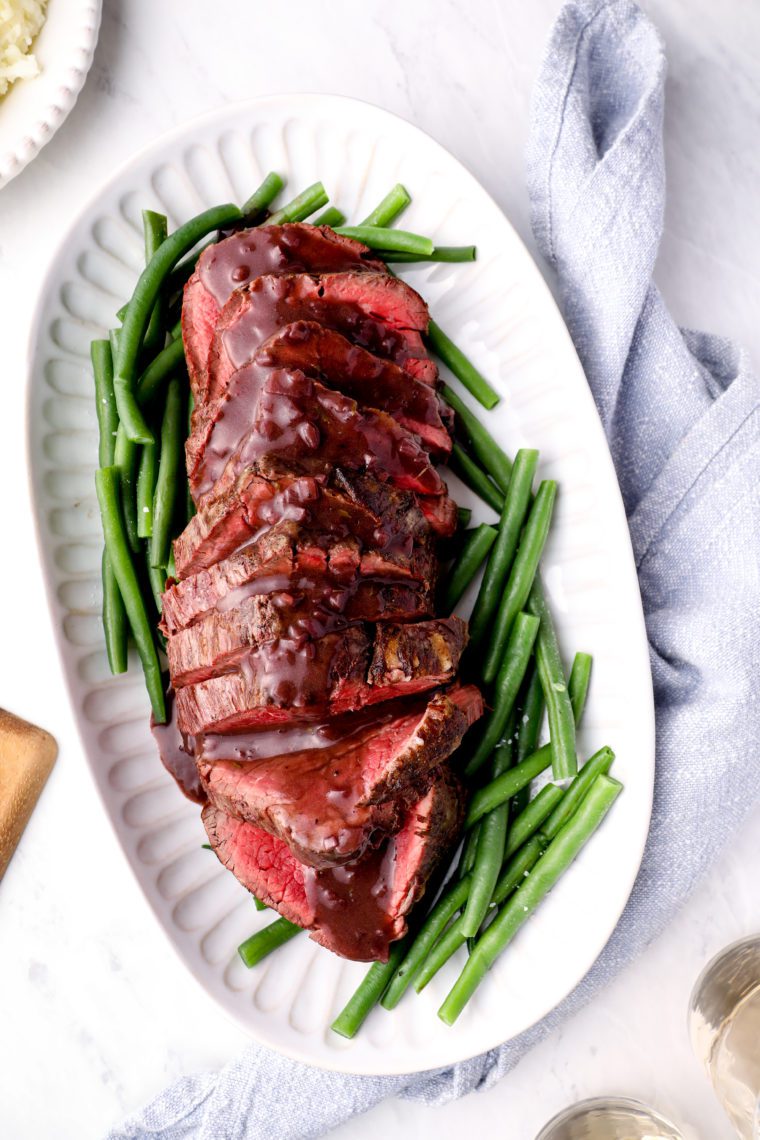
This beef tenderloin recipe is my #1 go-to recipe for holidays and special occasions. It never fails to impress, and my foolproof method ensures perfectly cooked beef every time, with no guesswork! The tenderloin is paired with a gorgeous French-style red wine reduction sauce, made by simmering a mixture of butter, shallots, red wine, and beef broth until the flavors deepen and intensify. Once reduced, a beurre manié (or flour and butter paste) is whisked in to thicken the sauce and give it a glossy sheen—yes, it’s fancy!
A great bonus is that the sauce can be prepared mostly in advance, so there’s very little fussing at the last minute. This beef tenderloin is truly the best of both worlds: simple to prepare yet incredibly delicious.
Table of Contents
“Voted best Christmas dinner ever! That is high praise. I served it with your thyme roasted carrots, shallot green beans and mashed potatoes. Thank you!”
Technique: Searing & Roasting Beef Tenderloin
Sear-roasting is an excellent method for cooking beef tenderloin. You begin by searing the tenderloin on the stovetop to create a beautifully crusty, brown exterior—this adds incredible flavor and texture to the lean cut. Next, transfer it to the oven and cook to your preferred doneness, using a leave-in meat thermometer with a remote monitor. These are readily available on Amazon or at kitchen stores and are a worthwhile investment for cooking pricey cuts like tenderloin. Plus, it’s great for other dishes too, like your Thanksgiving turkey.
What You’ll Need To Make Roast Beef Tenderloin With Red Wine Sauce
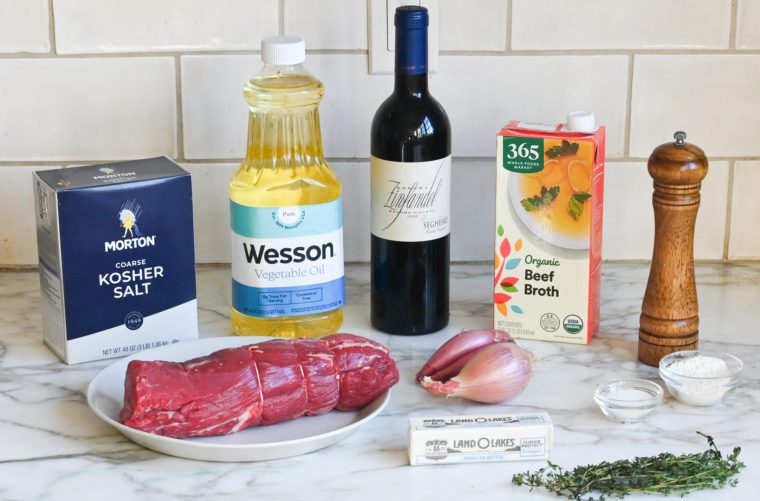
- Beef tenderloin: The most tender and expensive cut of beef available, beef tenderloin refers to the whole tenderloin before it is sliced into steaks. Once cut, those steaks are referred to as filet mignon (used in recipes like steak au poivre or pan-seared steaks). Beef tenderloin can be labeled and sold in different ways depending on the butcher or retailer. Common labels include “whole tenderloin,” “filet mignon,” “Chateaubriand,” or “tenderloin roast.”
- Butter: Provides richness and flavor. A portion is used for sautéing shallots, while the rest is combined with flour to create a beurre manié, which thickens the sauce.
- Shallots: Adds a sweet and mild onion flavor to the sauce.
- Red wine: Infuses the sauce with rich, fruity flavors and adds depth of color.
- Beef broth: Provides a savory base for the sauce; also used to deglaze the pan after roasting the beef.
- Thyme sprigs: Adds aromatic herbal notes to the sauce.
- All-purpose flour: Mixed with butter to create a beurre manié, a thickening agent for the sauce, giving it a smooth and velvety texture.
- Jump to the printable recipe for precise measurements
Step-by-Step Instructions
Step 1: Make the Sauce
Melt 5 tablespoons of the butter in a medium saucepan.
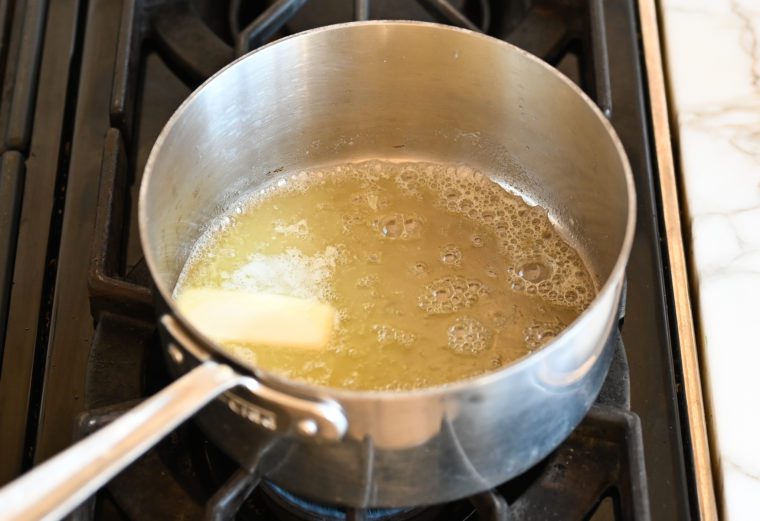
Add the shallots.
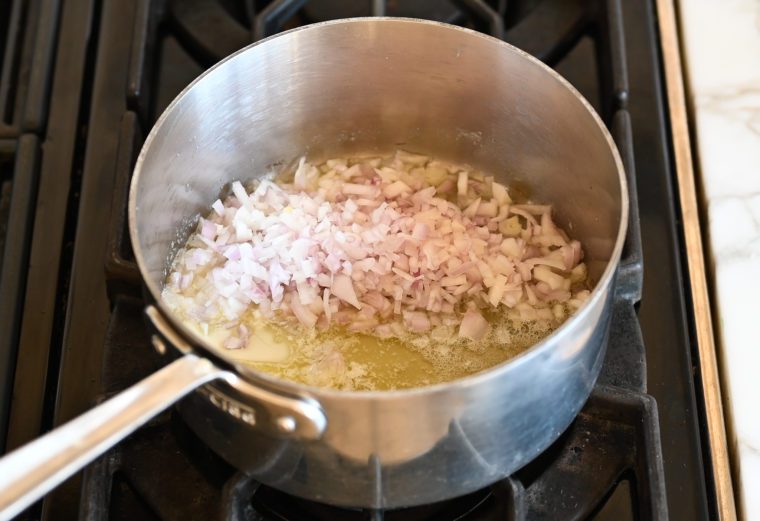
Cook over medium-low heat until soft and translucent, 7 to 8 minutes.
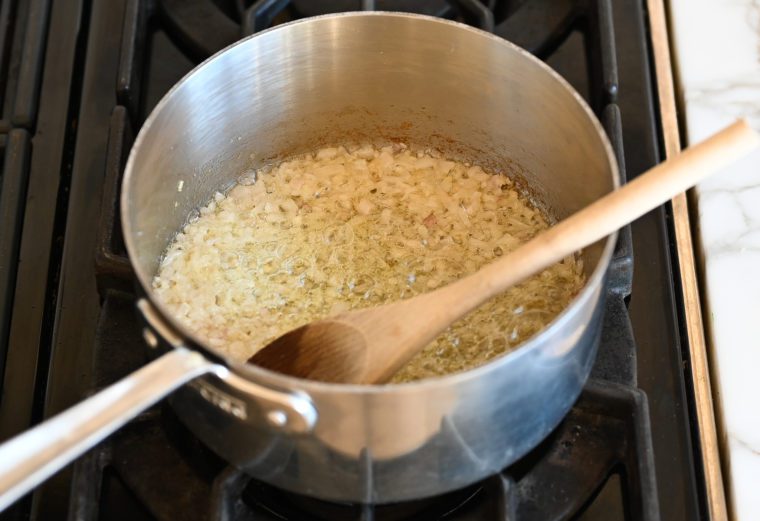
Add the wine, beef broth, thyme sprigs, salt, pepper and sugar, and bring to a boil.
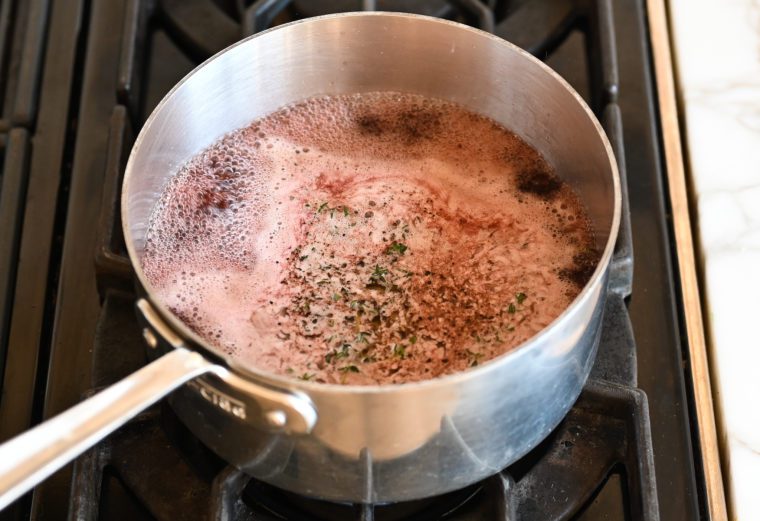
Cook over medium heat for about 30 minutes, or until the liquid is reduced by about half.
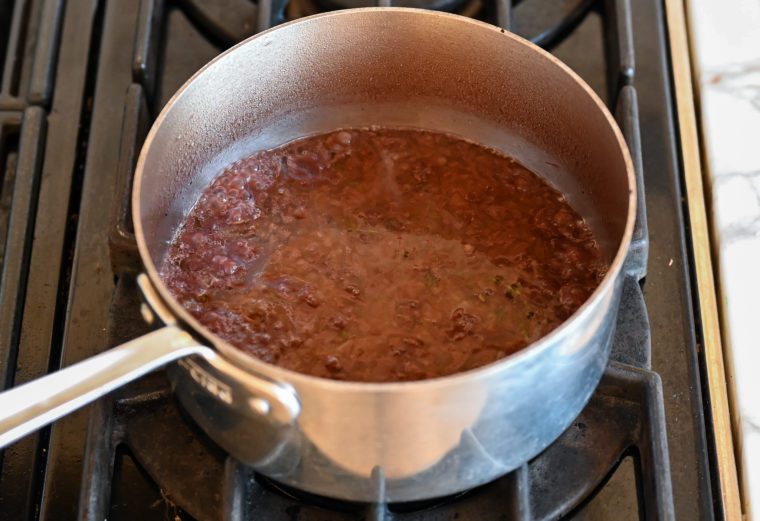
While the liquid is reducing, place the remaining 3 tablespoons of butter in a small bowl. Soften in the microwave (if necessary), then add the flour. Using a spoon, mix together into a paste. This is called a beurre manié, and it’s used to thicken sauces.
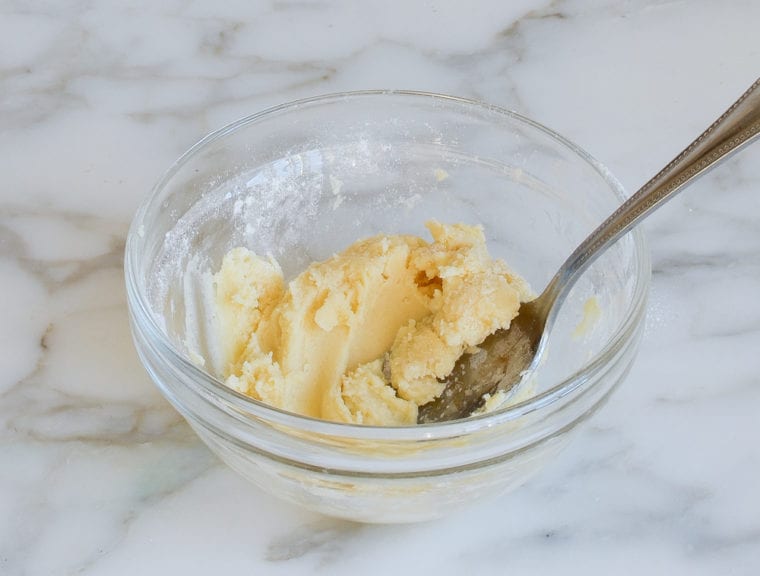
Once the wine mixture is reduced, reduce the heat to low and remove the thyme sprigs. Whisk the flour-butter mixture, a tablespoon at a time, into the simmering liquid, and simmer for a few minutes, until the sauce is thickened. The sauce can be made up to this point and refrigerated several days ahead of time.
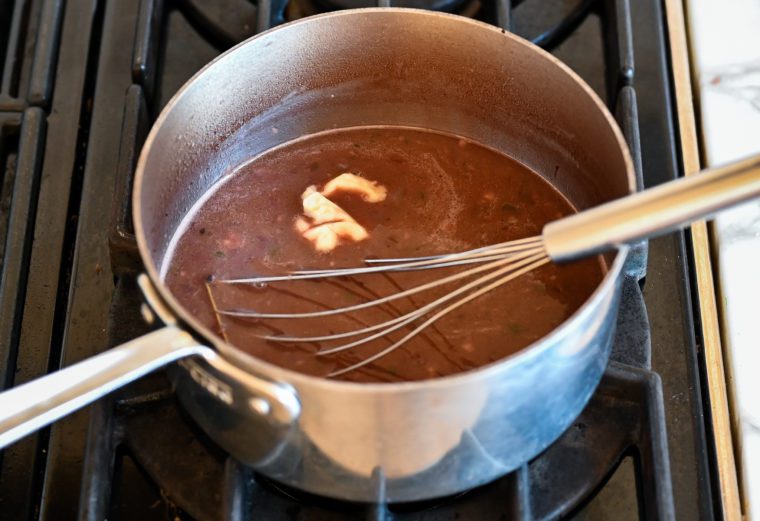
Step 2: Roast the Beef Tenderloin
Begin by seasoning the beef with kosher salt and freshly ground black pepper. Don’t be shy with the seasoning; it needs a lot.
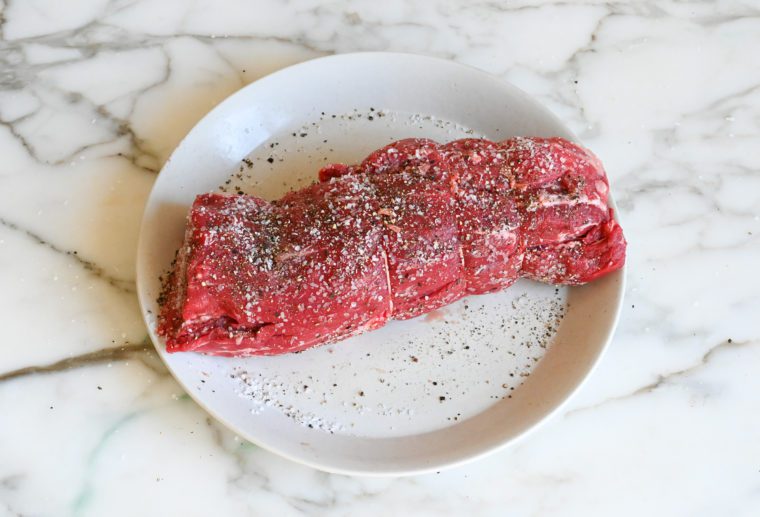
Heat the oil in an oven-proof skillet over medium-high heat until almost smoking. Cook, turning with tongs, until well browned with a nice crust on all but one side, about 10 minutes total.
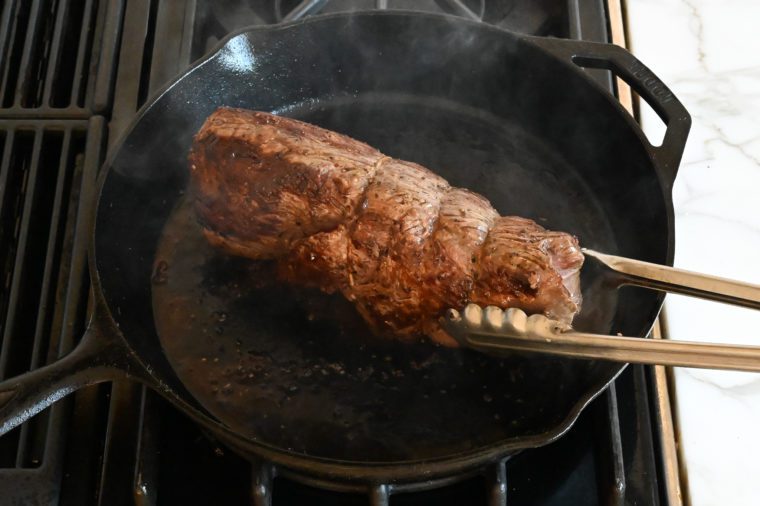
Turn the tenderloin so that the un-seared side is down and transfer the skillet directly to a 400°F oven.
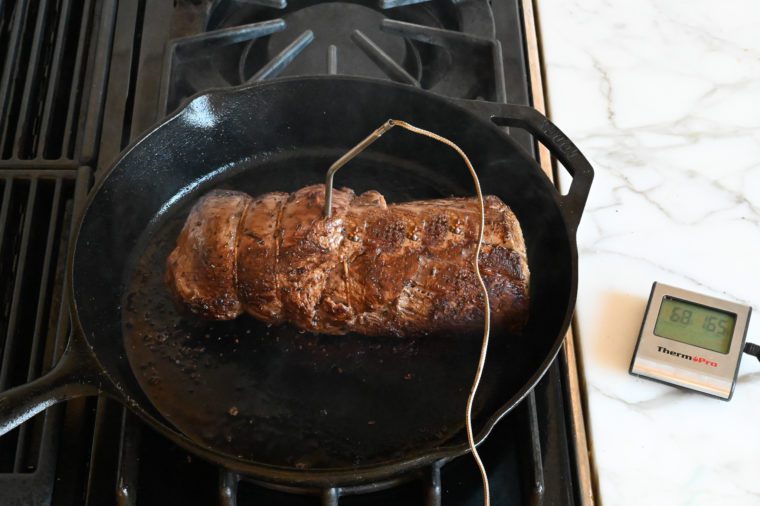
Roast until a thermometer inserted into the center of the meat registers 120ºF-125°F for medium-rare, 15 to 20 minutes, or until done to your liking. (Note that a perfect medium-rare roast will register around 130°F, but the internal temperature of the meat will continue to rise 5-10°F after it is removed from the oven, so it’s best to pull it out a little early to account for the carry-over cooking.) If you prefer your roast cooked to medium, pull it out of the oven at 130°F.
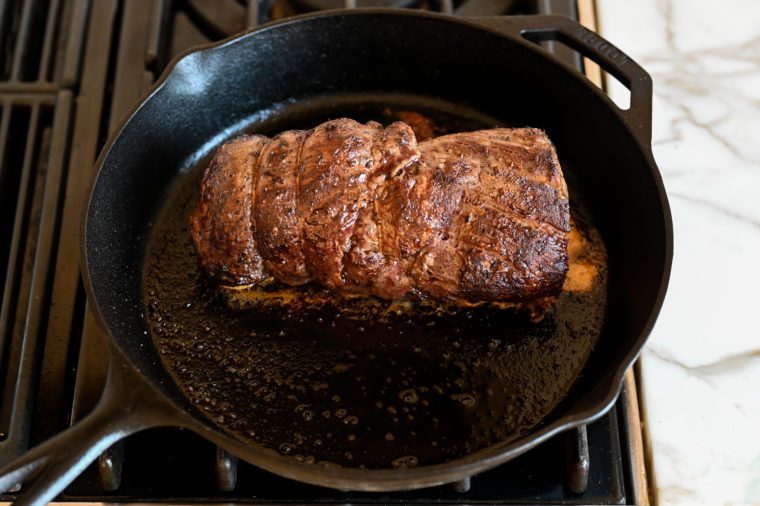
Step 3: Finish the Sauce & Carve the Tenderloin
Transfer the roast to a carving board (preferably with a well for collecting juices) and let it rest at room temperature, covered loosely with aluminum foil, for 10 to 15 minutes. This allows the juices to redistribute from the outside of the roast throughout the whole roast, making the tenderloin juicy. If you slice it too soon, the juices will pour out of it.
Meanwhile, pour off the fat from the roasting pan. Set the pan on the stovetop and add the beef broth. Bring the broth to a boil, using a wooden spoon to scrape the fond (brown bits) from the bottom of the pan.
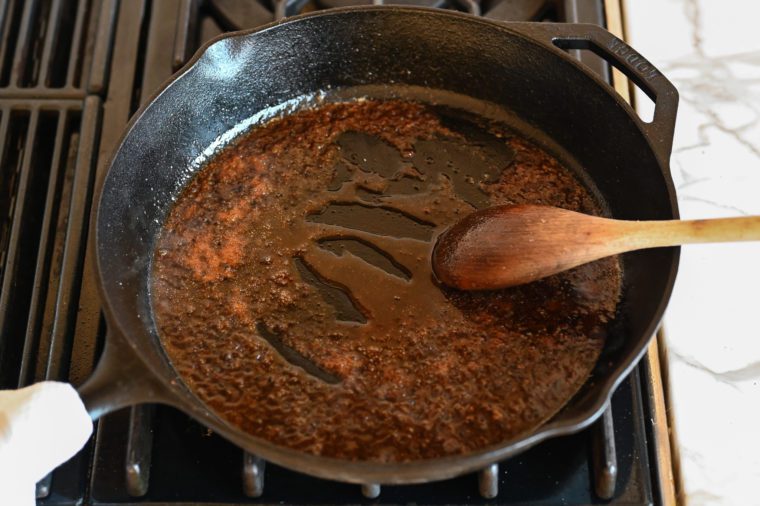
Add the flavorful broth to the red wine sauce, and bring the sauce to a simmer.
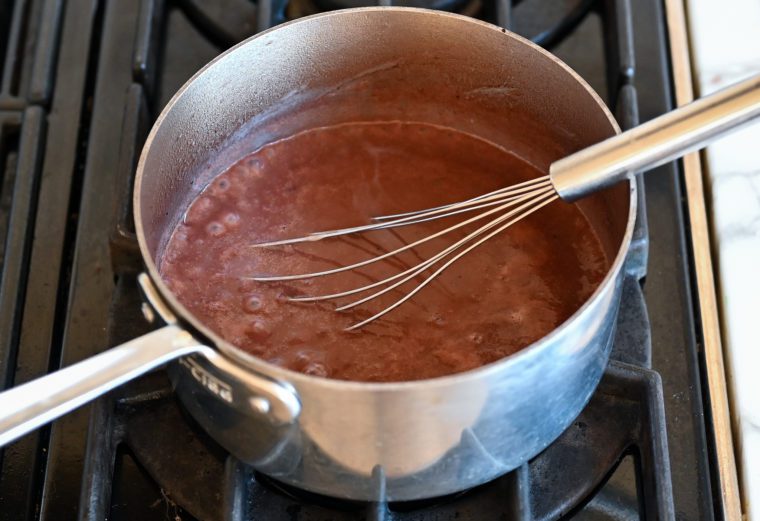
Carve the roast into 1/3-inch-thick slices.
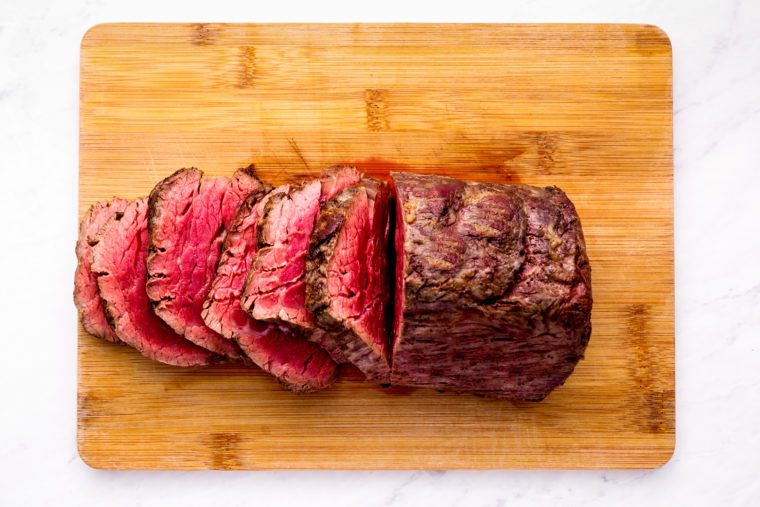
Serve the beef, passing the red wine sauce at the table.
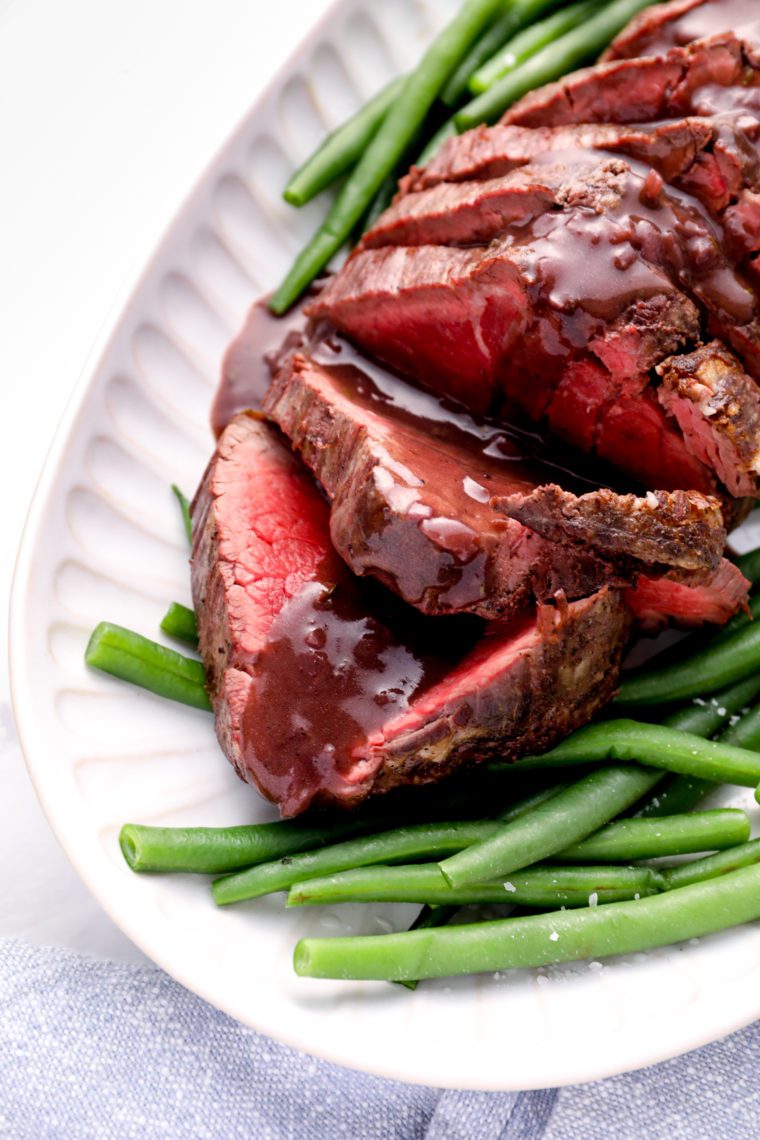
Frequently Asked Questions
Your tenderloin may have some butcher’s twine tied around one end of it; butchers often tie tenderloin up near the tapered end so that it is the same thickness all the way around. If yours comes that way, leave the string on until after it’s cooked. If it doesn’t, no worries—no need to do any tying.
When selecting a wine for the sauce, any red variety such as Merlot, Pinot Noir, Cabernet Sauvignon, Syrah, or Red Zinfandel will work well. It’s not necessary to overthink it or use anything too pricey; opt for a bottle that’s inexpensive yet still enjoyable to drink. Always avoid supermarket “cooking wines,” which contain salt and additives.
Unfortunately, I don’t recommend searing the beef in advance due to food safety concerns. Sear the beef just before cooking to be safe.
As a general guideline, plan for about 8 ounces (225 grams) of beef tenderloin per person for a generous serving. However, this can vary based on individual appetites and what other dishes you’re serving.
You May Also Like
Video Tutorial
Beef Tenderloin with Red Wine Sauce
Wow your guests with ease! My roasted beef tenderloin paired with a rich red wine sauce is simple, sophisticated, and foolproof.
Ingredients
For the Sauce
- 8 tablespoons unsalted butter, divided
- ¾ cup finely chopped shallots, from 2-3 large shallots
- 1¼ cups red wine
- 3 cups beef broth
- 6 fresh thyme sprigs
- ¼ teaspoon kosher salt
- ⅛ teaspoon ground black pepper
- 1 teaspoon sugar
- 2 tablespoons all-purpose flour
For the Beef
- 1 (2 to 3 lb) center-cut beef tenderloin roast
- Kosher salt (½ teaspoon per pound of beef)
- Freshly ground black pepper (¼ teaspoon per pound of beef)
- 2 tablespoons vegetable oil
- ¼ cup beef broth
Instructions
For the Sauce
- Melt 5 tablespoons of the butter in a medium saucepan. Add the shallots and cook over medium-low heat, stirring occasionally, until soft and translucent, 7 to 8 minutes. Add the wine, beef broth, thyme sprigs, salt, pepper and sugar, and bring to a boil. Cook over medium heat for about 30 minutes, or until the liquid is reduced by about half.
- While the liquid is reducing, place the remaining 3 tablespoons of butter in a small bowl and soften in the microwave, if necessary (it should be soft but not melted). Add the flour and, using a small spoon, mix into a smooth paste.
- Once the wine mixture is reduced, reduce the heat to low and remove the thyme sprigs. Whisk the flour-butter paste, a tablespoon at a time, into the simmering liquid, and simmer for a few minutes, until the sauce is thickened. Set aside. (The sauce can be made up to this point and refrigerated up to 3 days ahead of time.)
For the Tenderloin
- Let the beef stand at room temperature for 1 hour before roasting. Set an oven rack in the middle position and preheat the oven to 400°F.
- Season the beef all over with kosher salt and pepper. Heat the oil in an oven-proof skillet over medium-high heat until almost smoking. Cook, turning with tongs, until well browned on all but one side, about 10 minutes total. Turn the tenderloin so that the un-seared side is down, and transfer the skillet directly to the preheated oven. (If your pan isn't oven-proof, transfer the beef to a lightly oiled roasting pan.) Roast until a thermometer inserted into the center of the meat registers 120°F-125° for medium rare, about 15 minutes, or until done to your liking (115°F-120°F for rare, 130°F-135°F for medium). Keep in mind that these temperatures account for the fact that the temperature will continue to rise about 5 degrees while the meat rests.
- Transfer the meat to a carving board (preferably with a well for collecting juices) and let it rest, covered loosely with aluminum foil, for 10 to 15 minutes. Place a dishtowel or oven mitt over the handle of the roasting pan to remind yourself that it's hot.
- Meanwhile, carefully discard the fat from the roasting pan (remember that the handle is hot!). Set the pan on the stovetop and add the ¼ cup of broth. Bring the broth to a boil and, using a wooden spoon, scrape the fond, or brown bits, from the bottom of the pan. Add the flavorful broth to the red wine sauce, and then bring the sauce to a simmer.
- Carve the tenderloin into ½-inch-thick slices. Serve the beef, passing the red wine sauce at the table.
Pair with
Nutrition Information
Powered by ![]()
- Per serving (6 servings)
- Calories: 1,001
- Fat: 61 g
- Saturated fat: 26 g
- Carbohydrates: 9 g
- Sugar: 3 g
- Fiber: 1 g
- Protein: 49 g
- Sodium: 1093 mg
- Cholesterol: 233 mg
This website is written and produced for informational purposes only. I am not a certified nutritionist and the nutritional data on this site has not been evaluated or approved by a nutritionist or the Food and Drug Administration. Nutritional information is offered as a courtesy and should not be construed as a guarantee. The data is calculated through an online nutritional calculator, Edamam.com. Although I do my best to provide accurate nutritional information, these figures should be considered estimates only. Varying factors such as product types or brands purchased, natural fluctuations in fresh produce, and the way ingredients are processed change the effective nutritional information in any given recipe. Furthermore, different online calculators provide different results depending on their own nutrition fact sources and algorithms. To obtain the most accurate nutritional information in a given recipe, you should calculate the nutritional information with the actual ingredients used in your recipe, using your preferred nutrition calculator.

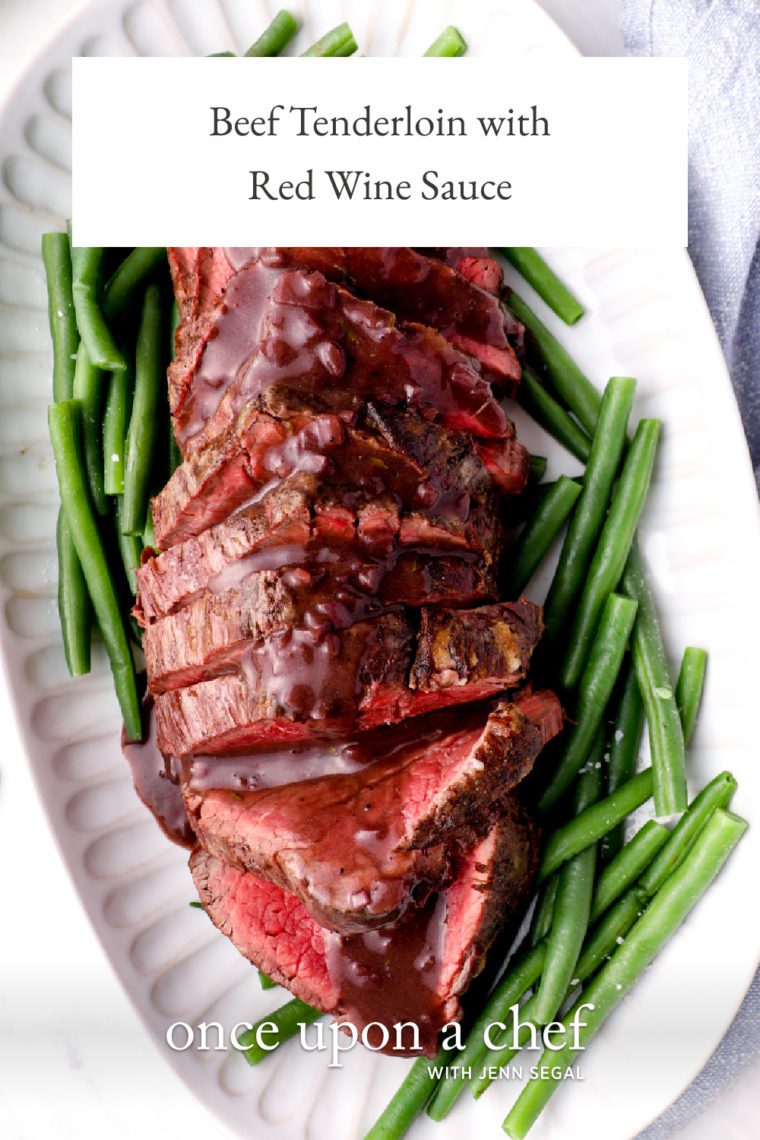
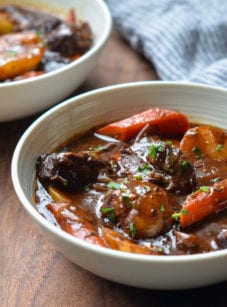
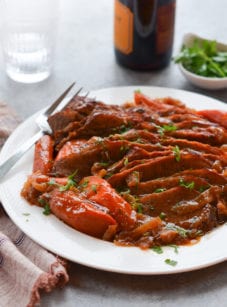

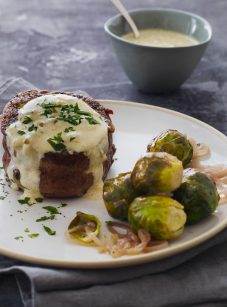
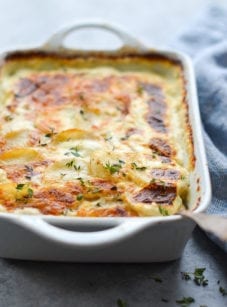
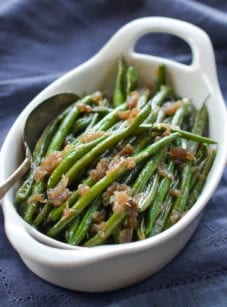

Hi, Jenn,
I tried leaving this question last week; I hope you view it today! I have guests coming for our Chanukah-Christmas dinner who absolutely cannot eat wheat at all. Is it possible to substitute cornstarch in the beurre manie? I’m hoping because it’s such a small amount of flour, the cornstarch sub won’t affect the taste. I hope you say yes! Thank you very much!
Hi Anne, Sorry I missed that! I think cornstarch will work, but I would go about incorporating it a bit differently. I would add all of the butter in the beginning, then instead of the beurre manie, I would make a cornstarch slurry with 2 tablespoons of cornstarch and 2 tablespoons of cold water. Add the slurry little by little at the end, whisking to combine and letting the sauce thicken with each addition, until the sauce is thickened to your liking. You may not need all of it. I’d love to know how it turns out if you try it!
Hello Jenn
Why is one side of the tenderloin left unseared?
Thank you
Debbie
Hi Debbie, It’s not necessary to sear that side as it’s the side that’s in contact with the skillet and will cook in the oven. Hope that clarifies!
Thank you Jenn for answering my question.
Dear Jenn,
My butcher said it is fine to purchase the tenderloin almost a week ahead of roasting. Is this really so?
The red wine sauce is the best!
Thank you!
Hi Diana, I’d typically trust the butcher, but a week sounds like a long time to me. If I were in your shoes, I’d probably wait to buy it until a little closer to serving it.
Hi Jenn
I had commented on the person who asked you this question, however I should’ve asked you. I purchased a large tenderloin from Costco , as I have done in the past. It’s vacuum sealed & says sell by 12/25? Now I’m concerned.do I need to freeze it? Or just let it be?
Thanks!
Hi Calley, If you leave it in the packaging it should be just fine in the fridge until Christmas (vacuum sealed meat typically keeps in the fridge for about 10 days), but if you’re nervous about it, I would call the butcher at Costco and ask what they recommend.
I have a very slight disagreement on the red wine choices for the sauce. Some of those in the list are fruit bombs, others are big tannin wines. Both of ends of the spectrum concentrate in the reduction. I personally have standardized on Petite Syrah for red wine sauce. When reduced it is neither “jammy” or astringent. With that modification, I am going to try this for my first turkey-less thanksgiving in 60+ years!
SO GOOD!!! I found this randomly when looking for a red wine sauce to add to a roast beef I was making. The sauce was AMAZING and I saved this recipe to try the whole thing. I’ve made it for 2 or 3 holidays so far and everyone loves it. I have never really been the one to cook the main course for a holiday (I usually make most of the sides) and this recipe is so well explained that you’d never know I’m an amateur. I will forever make this recipe for Christmas!!! THANK YOU!!
Can someone tell me how long I should leave it in the oven? I don’t like relying on a thermometer to tell me when my meat is done.
Meat doneness is a function of temperature not time. If you don’t believe me, learn about sous vide cooking. If I keep the bath at 130 degrees, it doesn’t matter if the meat is in for 1 hour or 3 hours – that steak will be medium no matter what.If you’re cooking by time, then I’m assuming that half the time when you cook your meat it’s either over-done or under-done (raw) or your frequently cutting into it to look.
Hi Jen! I have a port I’ve used to make a reduction for steaks before, do you think that would work well here too if I left out the sugar? Want to make this sauce to go with some seared sirloin soon
Hi Bubbles, I haven’t tried it, but I think it should work.
Update: it was fantastic! Thank you so much for this recipe!😄
Can I ask how much Port you used?
Delicious with one exception. Cooked it to 125 degrees before letting it rest, and for me that was over cooked. Should’ve cooked it to 120 degrees.
As long as I have been making the tenderloin roast or any beef roast, I always without fail, took the roast out at 120 degrees. Always came out medium rare.
Hi Jenn, just wondering roughly how many cups of red wine sauce I’ll get from 1 recipe. Thanks!
Hi Jane, I’d guesstimate it will give you about 2.5 cups of sauce.
Hello! I was wondering if this recipe could be made with a red wine substitute(if you abstain from using alcohol)
Thank you!
Hi Farah, unfortunately, there’s not a great substitute for the wine. This would also be nice with a horseradish cream sauce if you want to give that a try.
I have also done a non-alcoholic similar sauce (to the red wine) but using Urbani truffle paste. Both the black and white have been amazing. Essentially start with the same butter and shallot base and then add the truffle paste and finish with heavy cream. I kind of eyeball the amounts so forgive the lack of measurements. You will not need a thickening agent in this sauce.
You can use wine if you’re abstaining from alcohol because the recipe requires that you reduce and simmer for 30 minutes. All the alcohol will evaporate before the water content does because alcohol has a much lower heat of vaporization then water. After 30, minutes not one molecule of CH3 CH2 OH will exist in the sauce